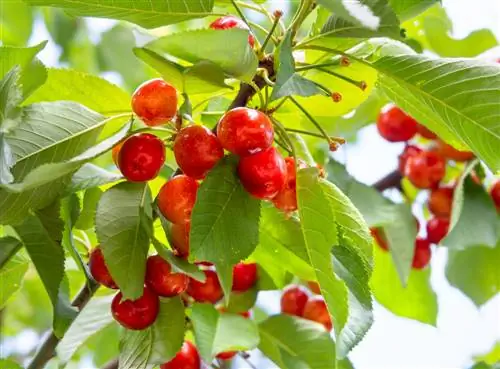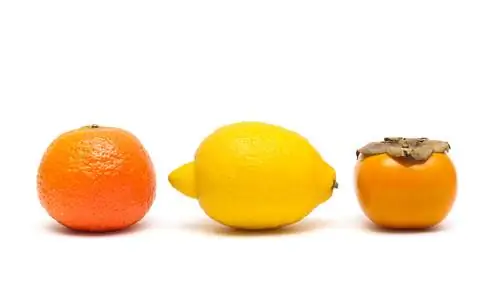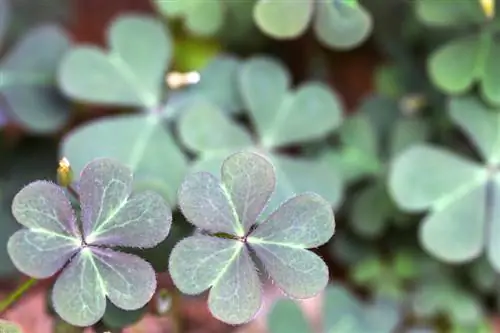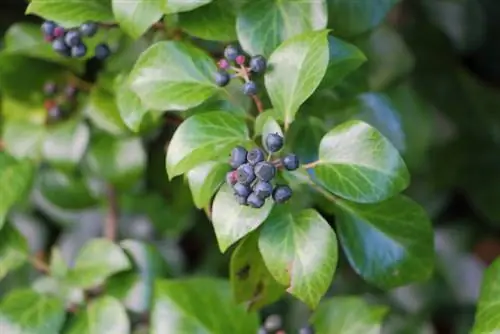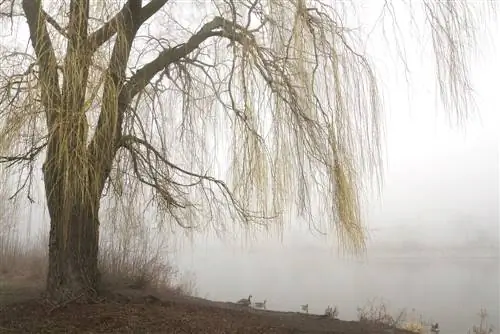- Author admin [email protected].
- Public 2023-12-16 16:46.
- Last modified 2025-01-23 11:22.
Read a commented profile about the bird cherry here. Find out here whether wild cherries are edible. Lots of tips about planting time, care and varieties.
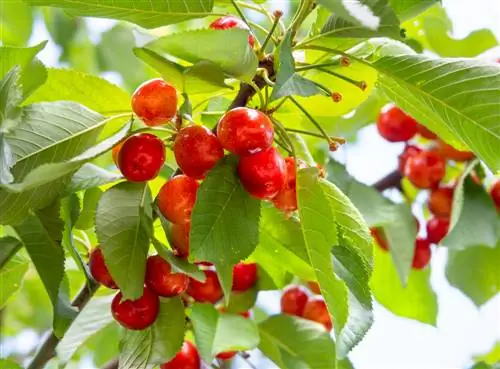
What is bird cherry and how to care for it?
The bird cherry (Prunus avium) is a deciduous tree that grows 15-20 meters high. It bears edible stone fruits that taste bittersweet to sugary-sweet depending on the variety. The planting time is ideally in autumn and care includes watering, fertilizing and pruning.
Profile
- Scientific name: Prunus avium
- Family: Rosaceae
- Synonyms: wild bird cherry, wild cherry, sweet cherry
- Species: wild forms, cultivated forms
- Growth type: deciduous tree
- Growth height: 15 m to 20 m
- Leaf: egg-shaped, pointed
- Flowers: thick, dense inflorescence
- Flowering period: April to May
- Fruits: Drupes
- Fruit properties: edible
- Taste: bittersweet to sugary-sweet
Growth type
The bird cherry grows as a medium-high, deciduous tree and only rarely as a shrub. The wild bird cherry is preferably cultivated because of its romantic flowers and decorative, edible stone fruits. In the wild, the powerful and light-hungry wild form can be admired on the edges of forests. The following characteristics characterize growth:
- Growth habit: upright, spreading, often multi-stemmed
- Crown: broadly conical, loose, densely bushy with thick branches and numerous short shoots
- Bark: initially smooth and shiny, later reddish-gray with reddish-brown lenticels (cork warts)
- Bark: dark brown to black, cracks with age
The growth of older bird cherries is characterized by a bark that peels off in a ring shape. Scientists suspect that the wild cherry and its cultivated forms are immune to mistletoe infestation because of this curly bark.
Leaf
The leaves provide important information if you want to accurately identify a bird cherry on the edge of the forest:
- Leaf shape: petiolate, obovate or oblong-ovate with serrated edge, tapering
- Leaf size: 3 cm to 7 cm long, 1 cm to 5 cm wide
- Arrangement: alternate
- Leaf color: fresh green and bare above, a shade darker with thin hairy nerves underneath
- Leaf veins: prominent main nerve with 7 to 12 side nerves
- Autumn color: yellow to reddish-orange
The peculiarities of bird cherry include small honey glands on the leaves. These are clearly visible on the leaf stem. For this reason, a cherry tree smells seductively of honey even outside of its fairytale blossoming period.
Bloom
Wisely, the bird cherry puts on its flower buds the previous year, setting the stage for a furious flowering magic from April to May. The following overview summarizes the defining characteristics of the cherry tree blossom:
- Inflorescence: umbel with 3 to 4 individual flowers, rarely 2 to 6.
- Single flower: five petals surround 20 to 25 shorter stamens.
- Size: 2.5cm to 3.5cm in diameter
- Flower color: white
- Position: on short shoots
- Arrangement: in dense clusters
- Flower ecology: hermaphrodite
Wild cherries bloom from 20 to 25 years old. On refined cultivars, the first flowering period occurs at the age of 3 to 4 years. A fully grown bird cherry and its cultivated forms boast up to a million flowers; a festival for bees, bumblebees and butterflies. As a pasture for bees and a source of food for birds, wild cherries are invaluable in natural gardens.
Fruits
In summer, the bird cherry carries a bittersweet burden of numerous, deep, dark red to black drupes that dangle promisingly from the short shoots. The profile states that wild cherries are edible. Further properties are characteristic of the fruits of Prunus avium:
- Diameter: 6 mm to 25 mm
- Fruit shape: spherical to ovoid
- Color when fully ripe: black-red
- Harvest time: June and July
For a wild cherry to bear fruit, a second cherry tree is required as a pollinator. Refined cultivars are generally self-fertile.
Species
When we talk about a bird cherry, it is usually a wild cherry. The suffix avium indicates that the stone fruits are often eaten by birds. Grosbeaks, a species of finch with steel-hard beaks, even happily crack and eat the hard stone core. In gardening terms, sweet cherries primarily refer to two cultivated forms whose fruits pamper the human palate with juicy, sweet pulp. The following table provides an overview:
| Bird cherry cultivated forms | Prunus avium | Prunus avium subsp. duracina | Prunus avium subsp. juliana |
|---|---|---|---|
| Status | Wildform | Culture form | Culture form |
| Name | bird cherry | Cartilaginous Cherry | Heartcherry |
| Leaf | 3 cm to 7 m | 5 cm to 15 cm | 5 cm to 15 cm |
| pulp | reddish, firm, dry | yellowish-reddish, solid | black-red, soft |
| Stonecore | 9-16mm | 7-9mm | 7-9mm |
With a growth height of up to 20 meters, the wild cherry and its cultivated forms are too large for many home gardens. Thanks to garden-friendly cultivars from the tree nursery, there is a suitable cherry tree for every garden.
Video: The best varieties of wild cherry for the garden
Planting bird cherry
Natural gardeners plant a wild cherry and a sweet cherry side by side. The wild stone fruits are reserved for birds, squirrels, hedgehogs and other hungry garden creatures. The juicy fruits of the sweet cherry are harvested for a fruity culinary delight. Another advantage of this planting strategy is that the wild bird cherry acts as a pollinator, which also optimizes the harvest yield of a self-fertile sweet cherry. When and how to plant Prunus avium correctly, read the following sections:
Planting time
The best time to plant cherry trees is in autumn. The time window for planting bare-root Heister remains open until spring. You can plant young trees in containers or with bales at any time of year, as long as the ground is not frozen.
Location
Important criteria for choosing a location are lighting conditions, soil conditions and space capacity. A wild cherry and its cultivated forms take up up to 50 square meters. When planting a slow-growing cultivar, please plan a space requirement of 10 to 12 square meters. In these locations a bird cherry reveals its full splendor:
- Wild form and cultivated forms: sunny to partially shaded
- Creation forms: full sun to sunny
- Microclimate: airy, warm, protected from late frosts
- Deep clay soil, fresh to moist, permeable and calcareous
- Exclusion criteria: wet, compacted garden soil with acidic pH below 6
Planting Tips
A properly planted bird cherry can live 100 years. Please pay special attention to these planting tips:
- Preparation: Place the root ball in water.
- Soil preparation: Dig the bed area two spades deep, weed, incorporate 3-5 liters of compost soil.
- Planting pit: double the volume of the root ball, enrich the excavation with horn shavings.
- Planting depth: corresponds to the planting depth in the container or in the nursery (note the earth mark).
- Support post: Drive in 1 to 3 posts, fix them to the trunk with hose ties.
- Watering edge: form a small wall out of bed soil as a watering edge for optimal water use.
Water a bird cherry on the day of planting and regularly in the following weeks. Drought stress is the most common cause of cherry trees failing to grow.
Excursus
Bird cherry donates Barbara branches
Bird cherries bear their buds on Saint Barbara, December 4th. If you cut off a few branches on this day, white cherry blossoms will shine under the Christmas tree just in time for Christmas. In order for Barbara branches to bloom, it should have frozen beforehand. If not, place the branches in the refrigerator for 24 hours.
Care for bird cherry
Wild cherries are very easy to care for. The older a cherry tree, the lower the need for water and nutrients. The focus of care is pruning at the right time. A nasty pest has set its sights on the delicious stone fruits. How to properly care for a bird cherry:
Pouring
A freshly planted bird cherry is watered regularly when the soil has dried out. Older, well-rooted cherry trees can survive normal rainfall. Only in extreme drought should you water the tree disc thoroughly in the early morning or in the evening.
Fertilize
Once a year, growth, flowering and crop yield benefit from organic fertilization. In March, spread 3 liters of mature compost with a few handfuls of horn shavings on the root disc. Rake in the fertilizer a little and then water with clear water.
Cutting
The bird cherry, its cultivated and cultivated forms are sensitive to cutting. Even the short shoots on the old wood bear the juicy stone fruits. These are two important reasons for planned pruning care. You can read the best tips about when to cut and cut here:
- Educational pruning: from the 1st to the 6th year in February, build the crown framework with a central shoot and 3 leading branches.
- Conservation pruning: cut and thin the cherry tree every 4 years after the harvest.
- Rejuvenation pruning: rejuvenate old, senescent bird cherry in stages in late winter, spread over 2 to 3 years.
For the correct cut, always place the pruning shears just above an outward-facing bud. Drooping branches that are more than 5 cm thick lead to an outward-pointing side shoot. Cut unfavorable, bare and dead branches back to short cones.
Pests
Nasty maggots in sweet cherries are the spawn of the cherry fruit fly. The dreaded pest lays its eggs in the ripening stone fruits. The beasts can be combated with protective nets (€20.00 on Amazon) over the crown and tree disc, yellow sticky traps, pecking chickens and nematodes of the type Steinernema feltiae.
Popular varieties
Wild and cultivated forms of bird cherry provide hobby gardeners with a variety of varieties with individual characteristics:
- Prunus avium 'Plena': delights with double, white flowers in April and overhanging branches, growth height 10 m to 12 m.
- Sweetheart: self-fruitful, late-ripening premium variety with medium-sized, dark red cherries and sugary-sweet flesh.
- Dönissen's yellow cartilaginous cherry: bears light yellow, bittersweet cherries, is avoided by birds and fruit flies, grows up to 5, 50 m.
- Prunus avium 'Duo': self-fertile wild cherry bush with two delicious varieties, height and width of 350 cm.
FAQ
Is bird cherry poisonous?
No, the fruits of a bird cherry are not poisonous, but edible. Only the stone core is slightly poisonous and therefore inedible. However, caution should always be exercised when consuming unknown cherries. Edible wild cherries are easily confused with poisonous belladonna. Both plants grow on the edges of forests and bear black-red, spherical fruits in summer.
What are important bird cherry characteristics?
A special feature of bird cherries is the pleasant honey scent. Surprisingly, it is not the white flower clusters that give off this scent, but the leaves. At the upper ends of the leaf stalks the reddish nectar glands are clearly visible to the interested observer. Another special feature is the ringlet bark on old cherry trees. Bird cherries probably use this trick to successfully defend themselves against mistletoe infestation.
What does cherry wood look like?
Cherry wood essentially impresses with its warm, reddish-brown color, which is sometimes streaked with green. The sapwood, on the other hand, is yellowish-white. When exposed to light, cherry wood can darken intensively and takes on a noble, golden yellow or dark red color. The annual rings are clearly visible.

